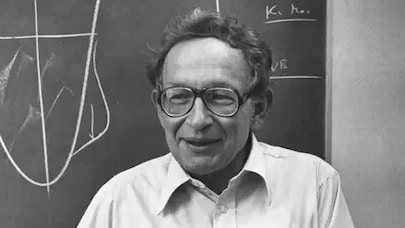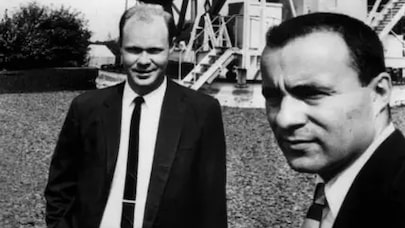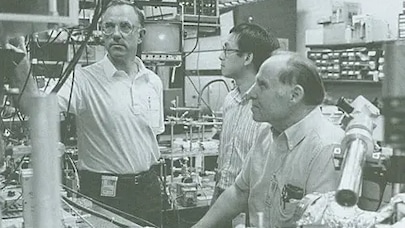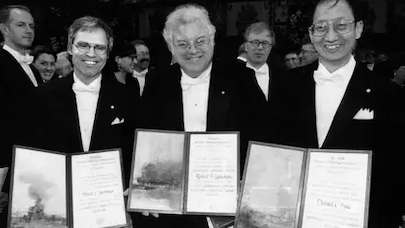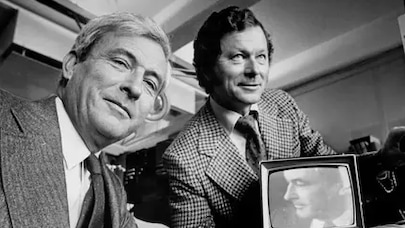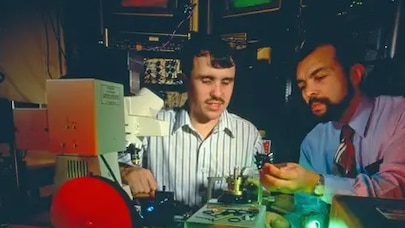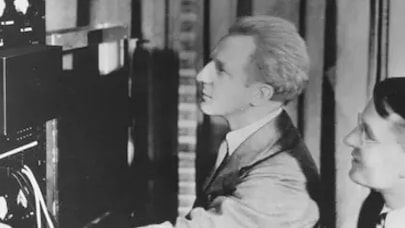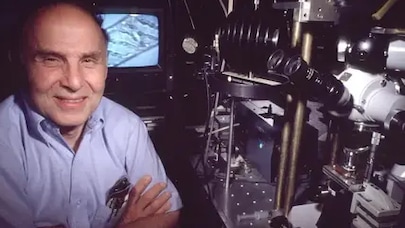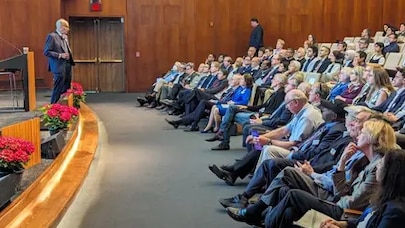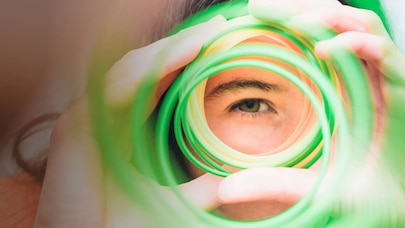Over the past 100 years, Nokia Bell Labs scientists have made many groundbreaking discoveries and innovations. These breakthroughs have been recognized in the awarding of hundreds of prestigious prizes, including ten Nobel Prizes and five Turing Awards.
The Nobel Prize is among the world’s most coveted awards for intellectual achievement. The Royal Swedish Academy of Sciences has awarded Nobel Prizes in Physics and Chemistry since 1901.
Nobel Prize - Louis Brus
Chemistry: discovery and development of quantum dots, nanoparticles so tiny that their size determines their properties (prize shared with Alexei Ekimov and Moungi Bawendi)
Nobel Prize - Arthur Ashkin
Physics: creation of optical tweezers and their application to biological systems. These tweezers use a laser's light to push particles into the center of the beam and hold them in place without harming them
Nobel Prize - Eric Betzig
Chemistry: development of super-resolved fluorescence microscopy, which is capable of measuring images of molecules from within living cells
Nobel Prize —Willard S Boyle and George E Smith
Physics: invention of the charge-coupled device for electronic memory, which made the charge-coupled device for image sensor possible
Nobel Prize —Horst Störmer, Daniel Tsui, and Robert Laughlin
Physics: discovery and explanation of a new form of quantum fluid with fractionally charged excitations (the Fractional Quantum Hall Effect)
Nobel Prize —Steven Chu
Physics: development of methods to cool and trap atoms with laser light (prize shared with Claude Cohen-Tannoudji and William D Phillips)
Nobel Prize —Arno A Penzias and Robert W Wilson
Physics: discovery of the cosmic microwave background radiation, which provided clear substantiation of the "Big Bang" theory of how the universe began
Nobel Prize —Philip W Anderson
Physics: development of fundamental theoretical insights into the electronic structure of magnetic and disordered systems (prize shared with Sir Nevill Francis Mott and John Hasbrouck van Vleck)
Nobel Prize —John Bardeen, Walter H Brattain and William Shockley
Physics: research on semiconductors that led to the invention of the transistor in 1947 and heralded the start of the digital age
Nobel Prize —Clinton J Davisson
Physics: discovery of the diffraction of electrons by crystals, which demonstrated the wave nature of matter (prize shared with George Paget Thomson)
First awarded in 1966 by the Association for Computing Machinery, the Turing Award is considered to be the highest distinction in computer science. It is presented to individuals who have made lasting and highly important contributions of a technical nature to the computing community.
2020 Turing Award —Alfred V Aho and Jeffrey Ullman
For fundamental algorithms and theory underlying programming language implementation.
2018 Turing Award —Yann LeCun
With Yoshua Bengio and Geoffrey Hinton, for conceptual and engineering breakthroughs that have made deep neural networks a critical component of computing.
1986 Turing Award —Robert E Tarjan
With John Hopcroft, for fundamental achievements in the design and analysis of algorithms and data structures.
1983 Turing Award —Dennis M Ritchie and Kenneth L Thompson
For development of generic operating systems theory and specifically for the implementation of the UNIX operating system.
1968 Turing Award —Richard W Hamming
For work on numerical methods, automatic coding systems, and error-detecting and error-correcting codes.
Since 1989, the Charles Stark Draper Prize has been awarded by the US National Academy of Engineering in recognition of outstanding achievements. It is considered among the highest forms of recognition within the field of engineering.
2018 Draper Prize —Bjarne Stroustrup
Conceptualizing and developing the C++ programming language
2013 Draper Prize —Richard F Frenkiel and Joel S Engel
Pioneering contributions to the world’s first cellular telephone networks, systems and standards
2006 Draper Prize —Willard S Boyle and George E Smith
The invention of the charge-coupled device (CCD), a light-sensitive component at the heart of digital cameras and other widely used imaging technologies
1999 Draper Prize —John B MacChesney
Conception and invention of optical fiber communications and development of manufacturing processes that made the telecommunications revolution possible
1995 Draper Prize —John R Pierce
Development of communication satellite technology
Established by the United States Congress in 1959 and first awarded in 1963, the National Medal of Science is presented by the US President to individuals “deserving of special recognition by reason of their outstanding contributions to knowledge in the physical, biological, mathematical, or engineering sciences.”
2024 US National Medal of Science —Ingrid Daubechies
For pioneering discoveries in the development of wavelets
2014 US National Medal of Science —Shirley Ann Jackson
Insightful work in condensed matter physics and particle physics, achievements in science-rooted public policy and inspiring the next generation of professionals in the science, technology, engineering, and math fields
1996 US National Medal of Science —Chandra Kumar Naranbhai Patel
Fundamental contributions to quantum electronics and invention of the carbon dioxide laser, which have had significant impact on industrial, scientific, medical and defense applications
1996 US National Medal of Science —James L Flanagan
Applying engineering techniques and speech science to solve underlying problems in speech communication
1993 US National Medal of Science —Alfred Y Cho
Pioneering research leading to the development of molecular beam epitaxy, a technique that revolutionized thin film growth by making atomically accurate structures for electronic and optoelectronic devices, and for the study of new quantum phenomena
1991 US National Medal of Science —Arthur L Schawlow
The conception of the laser and advancement of its applications, especially in laser spectroscopy
1988 US National Medal of Science —William O Baker
Pioneering studies of the complex relationships between the molecular structures and physical properties of polymers; a distinguished record of leadership in the combined disciplines of science and engineering; and distinguished service to government and education
1986 US National Medal of Science —Solomon J Buchsbaum
Wise contributions to national science and technology policy and studies of solid state plasmas
1982 US National Medal of Science —Philip W Anderson
Fundamental and comprehensive contributions to the theoretical understanding of condensed matter
1982 US National Medal of Science —Charles H Townes
Contributions to the understanding of matter through its interaction with electromagnetic radiations and the application of this knowledge towards the invention of the maser and laser
1974 US National Medal of Science —Rudolf Kompfner
Invention of the traveling-wave tube as well as highly significant scientific insights underlying communication satellites and optical communications
1973 US National Medal of Science —John Wilder Tukey
Mathematical and theoretical statistical contributions, including the analytical tool known as fast Fourier transform, for understanding waveforms in fields from astrophysics to electrical engineering
1966 US National Medal of Science —Claude E Shannon
Brilliant contributions to the mathematical theories of communications and information processing
1963 US National Medal of Science —John R Pierce
Contributions to communications theory, electron optics and traveling-wave tubes, and for the analysis leading to worldwide radio communications using artificial earth satellites
Established by the United States Congress in 1980 and first awarded in 1985, the National Medal of Technology & Innovation is presented by the US President to individuals, teams or companies for accomplishments in the innovation, development, commercialization and management of technology.
2024 US National Medal of Technology & Innovation —Victor B. Lawrence
For a lifetime of prolific innovations in telecommunications and high-speed internet technology.
2010 US National Medal of Technology & Innovation —Michael F Tompsett
Pioneering work in materials and electronic technologies, including the design and development of the first charge-coupled device (CCD) imagers
2006 US National Medal of Technology & Innovation —Herwig Kogelnik
Pioneering research and leadership associated with lasers, optoelectronics, integrated optics and lightwave communication systems
2006 US National Medal of Technology & Innovation —James E West
Co-invention of the electret microphone in 1962. Ninety percent of the two billion microphones produced annually and used in everyday items such as telephones, hearing aids, camcorders and multimedia computers employ electret technology
2005 US National Medal of Technology & Innovation —Alfred Y Cho
Invention of the molecular beam epitaxy (MBE) technology and the development of this technology into an advanced electronic and photonic devices production tool
2001 US National Medal of Technology & Innovation —Arun N Netravali
Leadership in the field of communication systems and pioneering contributions that transformed TV from analog to digital
1998 US National Medal of Technology & Innovation —Dennis M Ritchie and Kenneth L Thompson
Development of UNIX® operating system and the C programming language
1994 US National Medal of Technology & Innovation —Richard F Frenkiel and Joel S Engel
Contributions to the theory, design and development of cellular mobile communications systems
1993 US National Medal of Technology & Innovation —Amos E Joel, Jr
Vision and leadership in introducing electronic switching and other related communications technology
1992 US National Medal of Technology & Innovation —W Lincoln Hawkins
Research leading to long-lived plastic coatings for communications cable, which has saved billions of dollars for telephone companies around the world
1990 US National Medal of Technology & Innovation —John S Mayo
Role in managing the conversion of the national switched telephone network from analog to digital-based technology
1985 US National Medal of Technology & Innovation —Bell Labs
Contributions over decades to modern communications systems – the first such honor for an institution
First awarded in 1917, the IEEE Medal of Honor is the highest form of recognition by the Institute of Electrical and Electronics Engineers.
2005 IEEE Medal of Honor —James L Flanagan
Sustained leadership and outstanding contributions in speech technology
2001 IEEE Medal of Honor —Herwig Kogelnik
Fundamental contributions to the science and technology of lasers and optoelectronics, and for leadership in research and development of photonics and lightwave communication systems
1994 IEEE Medal of Honor —Alfred Y Cho
Seminal contributions to the development of molecular beam epitaxy
1992 IEEE Medal of Honor —Amos E Joel, Jr
Fundamental contributions and leadership in telecommunications switching systems
1989 IEEE Medal of Honor —C Kumar N Patel
Fundamental contributions to quantum electronics, including the carbon dioxide laser and the spin-flip Raman laser
1982 IEEE Medal of Honor —John Wilder Tukey
Contributions to the spectral analysis of random processes and the fast Fourier transform algorithm
1981 IEEE Medal of Honor —Sidney Darlington
Fundamental contributions to filtering and signal processing leading to chirp radar
1980 IEEE Medal of Honor —William Shockley
Invention of the junction transistor, the analog and junction field-effect transistors, and the theory underlying their operation
1977 IEEE Medal of Honor —H Earl Vaughan
Vision, technical contributions and leadership in the development of the first high-capacity pulse-code modulation time-division telephone switching system
1975 IEEE Medal of Honor —John R Pierce
Pioneering concrete proposals and the realization of satellite communication experiments, and for contributions to the theory and design of traveling-wave tubes and the electron beam optics essential to this success
1973 IEEE Medal of Honor —Rudolf Kompfner
Major contribution to worldwide communication through the conception of the traveling-wave tube, which embodies a new principle of amplification
1971 IEEE Medal of Honor —John Bardeen
Profound contributions to the understanding of the conductivity of solids, to the invention of the transistor, and to the microscopic theory of superconductivity
1967 IEEE Medal of Honor —Charles H Townes
Significant contributions in the field of quantum electronics, which have led to the maser and the laser
1966 IEEE Medal of Honor —Claude E Shannon
Development of a mathematical theory of communication which unified and significantly advanced the state of the art
1963 IEEE Medal of Honor —George C Southworth
Pioneering contributions to microwave radio physics, radio astronomy and waveguide transmission
1960 IEEE Medal of Honor —Harry Nyquist
Fundamental contributions to a quantitative understanding of thermal noise, data transmission and negative feedback
1955 IEEE Medal of Honor —H T Friis
Outstanding technical contributions in the expansion of spectrum of radio frequencies and leadership
1949 IEEE Medal of Honor —Ralph Bown
Extensive contributions to the field of radio and for his leadership in Institute affairs
1946 IEEE Medal of Honor —R V L Hartley
Primary contributions on oscillating circuits, triode tubes and information transmission
1940 IEEE Medal of Honor —Lloyd Espenschied
Pioneering developments of radio telephony and effective contributions in international radio coordination
1936 IEEE Medal of Honor —G A Campbell
Fundamental contributions to the theory of electrical networks
1926 IEEE Medal of Honor —G W Pickard
Important contributions to crystal detectors, antennas, wave propagation and atmospherics
Established and endorsed by the Japanese cabinet in 1983 and first awarded in 1985, the Japan Prize is presented to individuals “whose original and outstanding achievements are not only scientifically impressive, but have also served to promote peace and prosperity for all mankind.”
2011 Japan Prize —Dennis M Ritchie and Kenneth L Thompson
Development of the UNIX operating system
2003 Japan Prize —Seiji Ogawa
Discovery of the principle for functional magnetic resonance imaging
1985 Japan Prize —John R Pierce
Outstanding achievement in the field of electronics and communications technologies
The Kyoto Prize is Japan’s highest private award for global achievement. The prize is given not only to those who are top representatives of their own respective field, but also to those who have contributed to humanity with their work.
2001 Kyoto Prize —Izuo Hayashi and Morton B Panish
Success in continuous operation of semiconductor lasers at room temperature – a pioneering step in optoelectronics
1989 Kyoto Prize —Amos E Joel, Jr
Pioneering contribution to the electronic switching technology for telecommunications, especially that based on the concept of stored program control
1985 Kyoto Prize —Claude E Shannon
Foundational mathematical scientific basis to the development of communication technology and the creation of a new branch of mathematics called information theory
The Queen Elizabeth Prize for Engineering, also known as the QEPrize, is a global engineering prize that rewards and celebrates the engineers responsible for a groundbreaking innovation in engineering that has been of global benefit to humanity.
2017 Queen Elizabeth Prize —Michael F Tompsett
Invention of the imaging semiconductor circuit or charge-coupled device (CCD) imager, the development of the first charge-coupled device color camera and image, and the invention of the video analog-to-digital converter chip used by most modern digital cameras and smartphones
2017 Queen Elizabeth Prize —George E Smith
Design of electronic memory that made the charge coupled device (CCD) image sensor possible
Established in 1985, the highly regarded C&C Prize is awarded by the NEC Corporation to individuals for research and development and/or pioneering work in the fields of semiconductors, computers, and/or telecommunications and in their integrated technologies.
2017 C&C Prize —Alfred V Aho
Outstanding contributions to laying the foundation of theoretical computer science and to education in that field through numerous influential publications
2007 C&C Prize —John B MacChesney
Pioneering contributions to research and development resulting in low-loss optical fiber
1999 C&C Prize —George E Smith and Willard S Boyle
Invention of the charge-coupled device (CCD)
1997 C&C Prize —Barry G Haskell and Arun N Netravali
Pioneering work in digital video data compression technology
1995 C&C Prize —Alfred Y Cho
Seminal contributions to molecular beam epitaxy, a technology that is revolutionizing high-performance optoelectronics and electronics for computers and communications
1995 C&C Prize —Akira Hasegawa
Discovery of Soliton in optical fiber and the pioneering contribution made in the application of ultra-high-speed optical fiber communication
1991 C&C Prize —Jack M Sipress
Leadership in the development of high-speed digital fiber-guide systems that span the Atlantic Ocean and the Pacific Ocean, thereby giving global digital connectivity over high-capacity cables
1989 C&C Prize —Dennis M Ritchie and Kenneth L Thompson
Creation of UNIX operating system and the C programming language
1988 C&C Prize —Eric E Sumner, John S Mayo and M Robert Aaron
Pioneering contributions to the establishment of a basic technology for digital communications by developing T-1, the world’s first practical commercial high-speed digital communication system
1986 C&C Prize —Morton B Panish and Izuo Hayashi
Conception and development of the first room-temperature continuous-wave semiconductor injection laser with double heterostructure
Awarded by the Marconi Society since 1975, the Marconi Prize is granted to individuals who have made a significant contribution to the advancement of communications through scientific or technological discoveries.
2017 Marconi Prize —Arun N Netravali
Pioneering work on video compression standards that enabled a wide range of video services, including digital TV, HDTV and streaming video
2009 Marconi Prize —Andrew Chraplyvy and Robert Tkach
Insights into how information is transmitted over optical networks and finding innovative ways to significantly increase the speed and capacity of optical fiber communications systems
2001 Marconi Prize —Herwig Kogelnik
Fundamental contributions to developments in laser technology, optoelectronics, photonics and lightwave communications systems
1995 Marconi Prize —Jacob Ziv
Contributions to the fields of communications and information theory, and in particular for his work on the Lempel-Ziv data compression algorithm
1993 Marconi Prize —Izuo Hayashi
Pioneering contributions to optoelectronic technology and and lifelong contribution to communications science
1992 Marconi Prize —James L Flanagan
Pioneering contributions to speech technology
1987 Marconi Prize —Robert W Lucky
Invention of the automatically adaptive equalizer
1979 Marconi Prize —John R Pierce
Outstanding advances in space and satellite technologies relevant to improving world communications
1977 Marconi Prize —Arthur L Schawlow
Research in the fields of optical and microwave spectroscopy, nuclear quadruple resonance superconductivity and lasers
The National Inventors Hall of Fame is an American not-for-profit organization dedicated to honoring inventors and their inventions.
2019 National Inventors Hall of Fame —Dennis Ritchie and Ken Thompson
UNIX operating system
2016 National Inventors Hall of Fame —Victor B Lawrence
Signal processing in telecommunications
2013 National Inventors Hall of Fame —Arthur Ashkin
Optical trapping
2013 National Inventors Hall of Fame —Joseph Lechleider
Digital subscriber line
2012 National Inventors Hall of Fame —C Kumar N Patel
Carbon dioxide laser
2011 National Inventors Hall of Fame —Warren Marrison
Quartz clock
2010 National Inventors Hall of Fame —W Lincoln Hawkins
Polymer cable sheath
2010 National Inventors Hall of Fame —Field H Winslow
Polymer cable sheath
2010 National Inventors Hall of Fame —Vincent L Lanza
Polymer cable sheath
2009 National Inventors Hall of Fame —Gordon K Teal
Silicon transistor
2009 National Inventors Hall of Fame —Martin M (John) Atalla
MOSFET (metal–oxide–semiconductor field-effect transistor)
2009 National Inventors Hall of Fame —Dawon Kahng
Electric field-controlled semiconductor device
2009 National Inventors Hall of Fame —Alfred Y Cho
Molecular beam epitaxy (MBE)
2008 National Inventors Hall of Fame —Erna Schneider Hoover
Computerized telephone switching
2008 National Inventors Hall of Fame —Gerald L Pearson
Solar cell
2008 National Inventors Hall of Fame —Amos E Joel, Jr
Switching concept for cellular phones
2008 National Inventors Hall of Fame —Calvin S Fuller
Solar cell
2008 National Inventors Hall of Fame —Daryl M Chapin
Solar cell
2006 National Inventors Hall of Fame —Willard S Boyle
Charge-coupled device
2006 National Inventors Hall of Fame —Robert Kahn
Transmission Control Protocol/Internet Protocol
2006 National Inventors Hall of Fame —Herman A Affel
Coaxial cable
2006 National Inventors Hall of Fame —George E Smith
Charge-coupled device
2006 National Inventors Hall of Fame —Ali Javan
Helium neon laser
2006 National Inventors Hall of Fame —Lloyd Espenschied
Coaxial cable
2004 National Inventors Hall of Fame —Bernard M Oliver
Pulse-code modulation
2004 National Inventors Hall of Fame —Claude E Shannon
Pulse-code modulation
2003 National Inventors Hall of Fame —John R Pierce
Communications satellite
1999 National Inventors Hall of Fame —Gerhard M Sessler and James E West
Electret microphone
1996 National Inventors Hall of Fame —Arthur L Schawlow
Laser
1991 National Inventors Hall of Fame —Robert Williams
Vitamin synthesis
1983 National Inventors Hall of Fame —George R Stibitz
Digital computer
1981 National Inventors Hall of Fame —Harold Stephen Black
Feedback amplifier
1976 National Inventors Hall of Fame —Charles H Townes
Laser
1974 National Inventors Hall of Fame —John Bardeen
Transistor
1974 National Inventors Hall of Fame —William Shockley
Transistor
1974 National Inventors Hall of Fame —Walter H Brattain
Transistor
The Rumford Prize, awarded by the American Academy of Arts and Sciences, is one of the oldest scientific prizes in the United States. The prize recognizes contributions by scientists to the fields of heat and light.
2015 American Academy of Arts and Sciences - Rumford Prize —Federico Capasso and Alfred Y Cho
Invention and application of laser technology
1961 American Academy of Arts and Sciences - Rumford Prize —Charles H Townes
Development of the laser
1951 American Academy of Arts and Sciences - Rumford Prize —Herbert E Ives
Noteworthy contributions to optics
The IEEE Alexander Graham Bell Medal is an award honoring exceptional contributions to the advancement of communications sciences and engineering in the field of telecommunications.
2013 IEEE Alexander Graham Bell Medal —Andrew R Chraplyvvy and Robert W Tkach
Contributions to the science and technology of optical communications by enabling high-speed wavelength division multiplexing through the mitigation of the effects of fiber nonlinearity
2008 IEEE Alexander Graham Bell Medal —Gerard J Foschini
Seminal contributions to the science and technology of multiple-antenna wireless communications
1991 IEEE Alexander Graham Bell Medal —Arun N Netravali
Invention and development of predictive coding of pictures and picture sequences
1989 IEEE Alexander Graham Bell Medal —Gerald R Ash and Billy B Oliver
Contributions to the conception and implementation of dynamic nonhierarchical routing (DNHR) in telecommunications networks
1987 IEEE Alexander Graham Bell Medal —Richard H Frenkiel and William C Jakes
Fundamental contributions to the theory, design and deployment of cellular mobile communications systems
1981 IEEE Alexander Graham Bell Medal —David Slepian
Fundamental contributions to communication theory
1978 IEEE Alexander Graham Bell Medal —M Robert Aaron
Personal contributions to, and leadership in, the practical realization of high-speed digital communications
1978 IEEE Alexander Graham Bell Medal —John S Mayo
Fundamental contributions to communication theory
1978 IEEE Alexander Graham Bell Medal —Eric E Sumner
Fundamental contributions to communication theory
1976 IEEE Alexander Graham Bell Medal —Amos E Joel, Jr William Keister and Raymond W Ketchledge
Conception and development of electronic switching systems and their effective introduction into a nationwide telephone system
The Academy Award of Merit is presented annually by the Academy of Motion Picture Arts and Sciences for excellence in association with cinema.
1936 Academy Award —Edward C Wente and Bell Labs
Scientific and Engineering Award for their multicellular high-frequency horn and receiver
Since 1959, the National Academy of Recording Arts and Sciences has honored individuals and organizations with the Grammy Award® to recognize outstanding achievements in the field of music.
2016 Grammy Award —Harvey Fletcher
Technical Grammy Award for work on stereo sound
2006 Grammy Award —Bell Labs
Outstanding technical contributions to the recording field
The Academy of Television Arts & Sciences and the National Academy of Television Arts & Sciences present their Technology Emmy® Awards in recognition of excellence in the television industry.
2020 Technology Emmy® Award —Nokia Bell Labs
Pioneering development of the charge-coupled device (CCD) image sensor
2016 Technology Emmy® Award —Bell Labs
Pioneering invention and deployment of fiber-optic cable
1997 Technology Emmy® Award —Bell Labs
Work on digital television as part of the HDTV Grand Alliance
Election to the NAE is considered to be among the highest recognitions in engineering-related fields.
2019 US National Academy of Engineering Membership —David J Bishop
Contributions and leadership in high-capacity optical switch technology
2017 US National Academy of Engineering Membership —Peter J Winzer
Contributions to high-speed coherent optical communication systems
2017 US National Academy of Engineering Membership —Yann LeCun
Developing convolutional neural networks and their applications in computer vision and other areas of artificial intelligence
2017 US National Academy of Engineering Membership —Reinaldo A Valenzuela
Leadership in development of multiantenna wireless communication systems and channel modeling
2016 US National Academy of Engineering Membership —Mehdi Hatamian
Contributions to development of integrated circuits for video, communications and digital signal processing
2012 US National Academy of Engineering Membership —Roger Stolen
Contributions to fiber nonlinear optics and invention of polarization preserving fiber
2012 US National Academy of Engineering Membership —Alan H Gnauck
Contributions to high-speed, high-capacity lightwave communications systems
2010 US National Academy of Engineering Membership —Randy Giles
Contributions to advanced lightwave communication networks including erbium-doped fiber amplifiers, fiber Bragg grating-based subsystems and microelectromechanical systems (MEMS) crossconnects
2009 US National Academy of Engineering Membership —Bob Tkach
Contributions to research and development of terabit-per-second optical-fiber communication systems and networks
2009 US National Academy of Engineering Membership —Gerard J Foschini
Contributions to the science and technology of wireless communications with multiple antennas for transmission and receiving
2005 US National Academy of Engineering Membership —Richard D Gitlin
Contributions to communications systems and networking
2004 US National Academy of Engineering Membership —Young-Kai Chen
Contributions to the development of high-speed compound semiconductor electronics and optoelectronics for telecommunications
2004 US National Academy of Engineering Membership —Jeong H Kim
Contributions to national defense and security through improved battlefield communication
2003 US National Academy of Engineering Membership —Rod C Alferness
Contributions to the development of electro-optic devices and circuits for lightwave transmission and switching systems
2003 US National Academy of Engineering Membership —Debasis Mitra
Contributions to the modeling, analysis and design of communication networks
2003 US National Academy of Engineering Membership —Victor B Lawrence
Contributions to data communications
2002 US National Academy of Engineering Membership —Kenneth Walker
For innovation and leadership in the fundamental understanding and process development for optical fibers and fiber devices
2002 US National Academy of Engineering Membership —Cherry A Murray
For seminal work on order-disorder transitions in colloidal systems, and for leadership in bringing new concepts from research to production
2002 US National Academy of Engineering Membership —Andrew Chraplyvy
Contributions to the development of high-capacity optical fiber communication systems
1999 US National Academy of Engineering Membership —Peter G Simpkins
For contributions to the understanding and development of processes fundamental to the manufacture of low-loss, high-strength optical fiber
1998 US National Academy of Engineering Membership —Jack M Sipress
Development and implementation of international communications facilities via undersea lightwave cables
1998 US National Academy of Engineering Membership —Charles H Townes
Development of the maser and laser
1995 US National Academy of Engineering Membership —Elsa Reichmanis
Discovery, development and engineering leadership of new families of lithographic materials and processes that enable VLSI manufacturing
1995 US National Academy of Engineering Membership —John M Rowell
Experimental contributions to superconducting tunneling and leadership in the application of superconducting devices
1993 US National Academy of Engineering Membership —Linn F Mollenauer
Contributions to the realization of soliton-based, ultra-high-capacity lightwave communication
1992 US National Academy of Engineering Membership —Ralph A Logan
Contributions to the development of solid-state lasers
1992 US National Academy of Engineering Membership —T Dixon Dudderar
Significant contributions to the development of optical metrology and its applications to the packaging of high-performance electronic systems
1992 US National Academy of Engineering Membership —Karl E Martersteck
Exceptional leadership in the development of electronic switching in global telephony
1989 US National Academy of Engineering Membership —James W Mitchell
Characterization and purification of electronic materials at the parts-per-billion level, and for the management of characterization activities
1989 US National Academy of Engineering Membership —Larry F Thompson
Advancement of electron-beam resist materials and technology for their manufacture
1988 US National Academy of Engineering Membership —Donald E Procknow
Outstanding leadership of a premier telecommunications manufacturing institution through an era of technological change
1988 US National Academy of Engineering Membership —Dennis M Ritchie
Development of the C programming language and for codevelopment of the UNIX operating system
1987 US National Academy of Engineering Membership —Alastair M Glass
For important contributions and technological leadership in the development of electronic materials for electro-optics, harmonic generation, detection, and displays
1986 US National Academy of Engineering Membership —Walter L Brown
Discovery of semiconductor surface channels crucial in field effect transistors and contributions to ion beam uses in semiconductor diagnostics and processing
1986 US National Academy of Engineering Membership —Morton B Panish
Contributions to the conceptualization and fabrication of heterojunction semiconductor lasers
1985 US National Academy of Engineering Membership —John B MacChesney
Leadership in the invention of processes to make glasses for optical fiber and the transfer of these processes to manufacturing
1985 US National Academy of Engineering Membership —Claude E Shannon
Devising of a mathematical theory of communication, now called information theory
1985 US National Academy of Engineering Membership —James P Gordon
Fundamental contributions to quantum electronics, including demonstration of the first maser and demonstration of the information theory of optical communication channels
1985 US National Academy of Engineering Membership —Klaus D Bowers
Contributions to and management of solid-state optical, magnetic and semiconductor research and development
1985 US National Academy of Engineering Membership —Al Cho
Pioneering development of a molecular beam epitaxy technique, leading to unique semiconductor layer device structures
1984 US National Academy of Engineering Membership —Ivan P Kaminow
Basic contributions to optical telecommunications in the areas of electro-optic modulation, integrated optics, optical fibers and semiconductor lasers
1984 US National Academy of Engineering Membership —David W McCall
Leadership in the engineering of polymers for high performance and reliability in communications and electronics
1984 US National Academy of Engineering Membership —Arthur Ashkin
Contributions to quantum electronics, nonlinear optics, and seminal studies of optical levitation of small particles
1983 US National Academy of Engineering Membership —George E Smith
Invention of the charge-coupled device and contributions and leadership in the field of electron devices
1983 US National Academy of Engineering Membership —Lawrence R Rabiner
Contributions to digital signal processing and speech communications research
1982 US National Academy of Engineering Membership —John E Kunzler
Practical realization of high-field superconducting solenoids
1981 US National Academy of Engineering Membership —Amos E Joel, Jr.
Inventions and contributions to switching system developments for the nationwide public telecommunications network
1980 US National Academy of Engineering Membership —Tingye Li
Co-discovering the existence of low-loss electromagnetic-wave modes in open structures with application to laser resonators
1980 US National Academy of Engineering Membership —Kenneth L Thompson
Designing the UNIX operating system, which provided efficiency, breadth, power and style that have guided a generation's exploitation of minicomputers
1980 US National Academy of Engineering Membership —Robert A Laudise
Achievements in growing single crystals and pioneering efforts in the discovery of electronic materials
1979 US National Academy of Engineering Membership —Manfred R Schroeder
Founding the statistical theory of wave propagation in multi-mode media and contributions to speech coding and acoustics
1979 US National Academy of Engineering Membership —John S Mayo
Contributions and leadership in the realization of digital facilities for the telecommunications network
1978 US National Academy of Engineering Membership —Robert W Lucky
Contributions to the theory and practical development of data communication systems
1978 US National Academy of Engineering Membership —C Kumar N Patel
Contributions in the fields of molecular lasers and optical spectroscopy
1978 US National Academy of Engineering Membership —Herwig Kolgelnik
Contributions to the understanding of optical propagation modes, thick film holography and the invention of the distributed feedback laser
1978 US National Academy of Engineering Membership —James L Flanagan
Contributions to the acoustic theory of speech and hearing processes and engineering applications of this knowledge to voice communication
1976 US National Academy of Engineering Membership —David Slepian
Contributions to the elucidation of fundamental limits that apply to the processes of communications, signal detection and data extraction
1976 US National Academy of Engineering Membership —Enrique A J Marcatili
Analysis and invention of novel electromagnetic-wave guiding structures at microwave and optical frequencies
1976 US National Academy of Engineering Membership —Eugene F O'Neill
Contributions in the engineering, development, and construction of telecommunication terminals and systems
1975 US National Academy of Engineering Membership —John A Hornbeck
Contributions to the development of electronic technology and leadership of national space and defense programs
1975 US National Academy of Engineering Membership —Ping-King Tien
Invention of, and engineering contributions to, microwave amplifiers and integrated optical circuits and devices
1975 US National Academy of Engineering Membership —William O Baker
Contributions leading to the exploitation of synthetic polymers in communications equipment, synthetic rubber, ablation heat shields and rocket propellants
1975 US National Academy of Engineering Membership —Andrew H Bobeck
Contributions to the field of magnetic bubbles, which have produced a new class of electronic devices
1974 US National Academy of Engineering Membership —Willard S Boyle
Contributions to solid-state electronics including the solid-state laser and charge-coupled device
1972 - US National Academy of Engineering Membership —John Bardeen
Contributions to the invention and development of the theory of superconductivity
1972 US National Academy of Engineering Membership —Morris Tanenbaum
Achievements in solid state research and technology and in technology transfer from research to manufacturing
1970 US National Academy of Engineering Membership —Alton C Dickieson
Director of the development of long-distance transmission facilities of the Bell System
1969 US National Academy of Engineering Membership —Brockway McMillan
Leadership in systems engineering in the field of communications and in large military projects industry
1966 US National Academy of Engineering Membership —James B Fisk
Communications research
1966 US National Academy of Engineering Membership —Rudolf Kompfner
Microwave tube engineering
1965 US National Academy of Engineering Membership —John R Pierce
Leading electronics engineer and satellite communications expert
Election to the National Academy of Science is considered to be among the highest recognitions in scientific fields.
2013 US National Academy of Science Membership —Winfried Denk
Systems Neuroscience and Cellular and Molecular Neuroscience
2001 US National Academy of Science Membership —David Tank
Physics and Systems Neuroscience
1999 US National Academy of Science Membership —Horst Stormer
Applied Physical Sciences
1996 US National Academy of Science Membership —Arthur Ashkin
Engineering Sciences
1994 US National Academy of Science Membership —Herwig Kogelnik
Applied Physical Sciences
1991 US National Academy of Science Membership —Robert A Laudise
Engineering Sciences
1988 US National Academy of Science Membership —James P Gordon
Engineering Sciences
1985 US National Academy of Science Membership —Kenneth L Thompson
Computer and Information Sciences
1985 US National Academy of Science Membership —Alfred Y Cho
Engineering Sciences
1979 US National Academy of Science Membership —Robert W Wilson
Astronomy and Physics
1978 US National Academy of Science Membership —Ping King Tien
Engineering Sciences
1977 US National Academy of Science Membership —David Slepian
Applied Mathematical Sciences
1975 US National Academy of Science Membership —Arno A Penzias
Astronomy
1961 US National Academy of Science Membership —William O Baker
Chemistry
1956 US National Academy of Science Membership —Claude E Shannon
Mathematics
The Grete Lundbeck European Brain Research Prize – known as The Brain Prize – is awarded to one or more scientists who have distinguished themselves with an outstanding contribution to European neuroscience and who are still active in research.
2015 The Brain Prize —David Tank, Winfried Denk, Karel Svoboda
For work that resulted in two-photon microscopes, now commercially available, that can be used to look at how brain processes (shared with Arthur Konnerth)
World Technology Awards brings together the most innovative people and organizations in science and technology from around the world, exploring what is imminent, possible and important in and around emerging technologies.
2014 World Technology Award —Holger Claussen
Small cells research
2011 World Technology Award —Gabriel Charlet
Communication technology
In addition to its International Fellowship Award, the the Marconi Society honors a small number of individuals for their lifetime of achievement.
2009 Marconi Society Lifetime Achievement Award —Amos E Joel, Jr
Recognition for his leading expertise in switching
2003 Marconi Society Lifetime Achievement Award —William O Baker
Widely recognized champion of communications research and development
2000 Marconi Society Lifetime Achievement Award —Claude E Shannon
Lifetime achievement in information theory
This medal is awarded to individuals who have made significant contributions to the advancement of science and technology, while successfully bringing innovation from the laboratory to the marketplace.
2024 New Jersey Science & Technology Medal —Brian Kernighan
Developing computer languages and authorship of the first book on the C programming language, leading C to being the most dominant computer language in the world
2023 New Jersey Science & Technology Medal —Victor Lawrence
Outstanding technical innovations that revolutionized data communications, boosting U.S. competitiveness and connecting billions globally
2019 New Jersey Science & Technology Medal —Arthur Ashkin
Groundbreaking invention of optical tweezers and their application to biological systems, which enables scientists to further unravel the mysteries of human life
2018 New Jersey Science & Technology Medal —Alfred Y Cho
Unique contributions to science and technology and successful public–private partnerships that drive innovation and STEM education
2016 New Jersey Science & Technology Medal —Marcus Weldon
Vision for Bell Labs and directing the organization’s innovation in the pivotal areas of foundational networking technologies and systems for the cloud networking era via 10x game-changing research and Future X projects
2015 New Jersey Science & Technology Medal —Robert W Wilson
Discovery of cosmic microwave background radiation
2013 New Jersey Science & Technology Medal —Morris Tanenbaum
Invention of diffused-base silicon transistor
2010 New Jersey Science & Technology Medal —George E Smith
Charge-coupled device
The decorations of the Orders of the White Rose of Finland and the Lion of Finland are conferred upon citizens who have distinguished themselves in the service of Finland. Foreign nationals may also be awarded decorations of the Orders.
2021 Finland Medal of Honor —Mikko Uusitalo
Cross of Merit of the Order of the White Rose of Finland
2021 Finland Medal of Honor —Kari Hooli
Cross of Merit of the Order of the White Rose of Finland
2020 Finland Medal of Honor —Jorma Pallonen
Cross of Merit of the Order of the White Rose of Finland
2019 Finland Medal of Honor —Mika Kasslin
Knight of the Order of the Lion of Finland
2019 Finland Medal of Honor —Silke Holtmanns
Knight of the Order of the Lion of Finland
2018 Finland Medal of Honor —Leo Kärkkäinen
Knight of the Order of the Lion of Finland
2018 Finland Medal of Honor —Esa Tiirola
Knight of the Order of the Lion of Finland
2017 Finland Medal of Honor —Kari Pajukoski
Knight of the Order of the Lion of Finland
2017 Finland Medal of Honor —Jari Mustajarvi
Cross of Merit of the Order of the White Rose of Finland
2017 Finland Medal of Honor —Karri Ranta-aho
Cross of Merit of the Order of the White Rose of Finland
2016 Finland Medal of Honor —Lauri Oksanen
Cross of Merit of the Order of the White Rose of Finland
2016 Finland Medal of Honor —Antti Toskala
Knight of the Order of the Lion of Finland
2016 Finland Medal of Honor —Harri Holma
Knight of the Order of the White Rose of Finland
